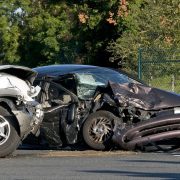What Does Your Motor Vehicle Insurance Policy Cover?
What does your insurance premium cover?
Kristy came to me after she was t-boned in Gaithersburg, MD after the careless driver ran a red light at an intersection. She had broken two ribs and injured her back. Further, her 2011 Audi A8 had sustained substantial property damage.
Kristy thought the insurance companies would be fair with her, and decided to handle her claim on her own. Three months later, she came to my office. She was getting bills from her medical providers that she could not afford to pay out of pocket, and the careless driver’s insurance company had offered her $1,500 to settle her claim, despite the fact that she had over $7,500.00 in medical bills.
They told her that her health insurance could pay all her bills.
The truth is that most people purchase motor vehicle insurance, and do not fully understand what it covers. Kristy was pleasantly surprised to learn from me what exactly she was entitled to under the law, including the diminution in value of her vehicle.
How much do you know about your motor vehicle insurance coverage? If the answer is about as much as Kristy knew, then following list of basic things covered by the typical motor vehicle insurance policy should be helpful:
Liability coverage: The main reason that we have motor vehicle insurance is to protect us from paying compensation to the victim out of pocket if we cause a collision. If you injure someone in a collision, your liability coverage will pay for the victim’s medical bills, lost wages, and non-economic damages (pain, suffering, inconvenience, etc.) up to your policy limits.
You can purchase different amounts of liability coverage. Every state requires that you have a minimum level of liability coverage to drive legally. For example, Maryland requires that you have a minimum $30,000 in liability coverage. The amount of liability coverage you purchase depends on the amount of risk that you feel comfortable incurring. Most insurance carriers offer $50K, $100K and $300K policies. If you have a high income or personal assets, insurance companies can also offer “umbrella” policies.
Most states will not allow you to get underinsured coverage or uninsured coverage above your liability limits (this will be discussed below).
Personal Injury Protection/Med Pay: Most insurance policies also contain a personal injury protection (“PIP”) provision. PIP, known in some states as “med pay”, is “no-fault” insurance. It is normally $2,500 and is used to pay for your own medical bills and lost wages. While Kristy was spending large amounts of money for her deductibles, she could have been using her PIP coverage for quick reimbursement. PIP coverage is available regardless of whether you are at fault.
Each state has different rules for what PIP/med pay can cover, and how it is applied. The personal injury attorneys at Dross Berman LLC can explain your PIP benefits to you.
Underinsured/Uninsured Motorist Coverage: “UM/UIM” coverage protects you if you are in a collision caused by someone else, and they do not have adequate coverage, or are uninsured completely. An example is if you are the victim of a “hit and run” collision, or if the careless driver has the minimum amount of insurance coverage. Almost always, your UM/UIM limits match your liability coverage.
It is VERY important to note that in order to use your UM/UIM coverage, you must notify your own insurance company prior to accepting the Defendant’s policy limits, otherwise you put your UM/UIM claim in jeopardy.
In addition, if you are the victim of a hit and run, no matter how minor the damage, it is important to call the police and get a report, otherwise your UM insurance could deny the claim.
The personal injury attorneys at Dross Berman LLC recommend that you contact them to discuss your UM/UIM coverage if you have been in a collision.
Collision coverage: Collision coverage is used to cover the property damage to your vehicle following a collision. Like liability coverage, you have a limit to your collision coverage as well. If you have low collision coverage, and you total someone’s 2013 BMW convertible, you may be personally responsible for the remainder of their property damage bill.
Your collision coverage goes both ways. You can use it to repair your car if you are hit by an uninsured driver. Also, if you are struck by a driver who is insured, but liability is in dispute, you can use your coverage, and pay your deductible out-of-pocket. Once liability is determined, you will get your deductible back if you are not at fault. Many people prefer to use their own insurance coverage for property damage because they can get their car fixed quickly, and not have to wait for an investigation.
Rental coverage: If you are involved in a collision, you will need a rental car while your vehicle is being repaired. If it is clear that the other person was the cause of the collision, their insurance will cover the rental car. If it is not clear, you can get a rental car through your own policy if you have rental coverage. A typical rental coverage is a “30/900” plan, meaning that you can rent a car for up to 30 days or $900, whichever occurs first.
If the collision is the other driver’s fault, you will be entitled to rental coverage, but only for a “reasonable” period. Generally this will be until your car is fixed, or, if your car is a total loss, about a week or so after you get paid for the car.
Miscellaneous: Most policies have little known benefits, and we urge you to contact your agent so you can take advantage of all the benefits of your policy. These can include free windshield glass repair for small cracks, or roadside assistance.
Of course, every insurance policy is different, and the personal injury attorneys at Dross Berman LLC would be happy to give you a free consultation regarding your rights following a collision at 240-403-7200.







